Know what the greatest feeling in the world is? It’s when you’re going to throw away an empty pack of Gushers Fruit Snacks and discover that there is one last one hidden in the corner.
No Longer Being A Bum
- Build a laser projector to augment a cloudy night sky. The plan here was to laser project stars, satellites, and other heavenly bodies onto the clouds in Pittsburgh, since nobody would be able to see them otherwise. I don’t think the weather will work for that in the Bay Area, but I could still project onto a ceiling or something.
- Implement a pretty basic portion of Johnny C. Lee’s thesis.
- Add Windows support to the camera module in Pygame. Linux support for webcams is finally being released with Pygame 1.9 fairly soon. Werner Laurensse is working on an OS X implementation for 1.9.1. It would be a bit strange to leave out perhaps the largest portion of Pygame’s audience.
Star Wars Uncut: Scene 437 in Stop Motion Photography
This is what happens (best case) when geeks have too much free time. My friend John Martin and I decided to take part in Star Wars Uncut, an experiment to recreate Star Wars: A New Hope in a series of several hundred 15 second chunks, each created by random people across the internet. I chose a scene with a pleasant blend of dialog and pyrotechnics.
John has an inordinate quantity of Star Wars merchandise, so we went with stop motion animation for the scene, something neither of us was familiar with. We found the actual action figures for almost every part of the 15 seconds, and really only had to improvise on the explosions, as we would rather not blow up collectibles.
With assistance from Peter Martin and Meg Blake, we fabricated Y-wings out of soda bottles, cardboard tubes, cardboard, and spray paint. We filled each with a mixture of half potassium nitrate and half sugar, lit it with a fuse, and dragged it with a string as we took pictures. As you can see by the video above, the results are reasonable for an afternoon of filming and a $0 budget.
eclecticc does encrypted logins
For the handful of you who login, the login and admin pages now use ssl via a cert from CAcert.
XBee Remote Trigger for CHDK Enabled Cameras
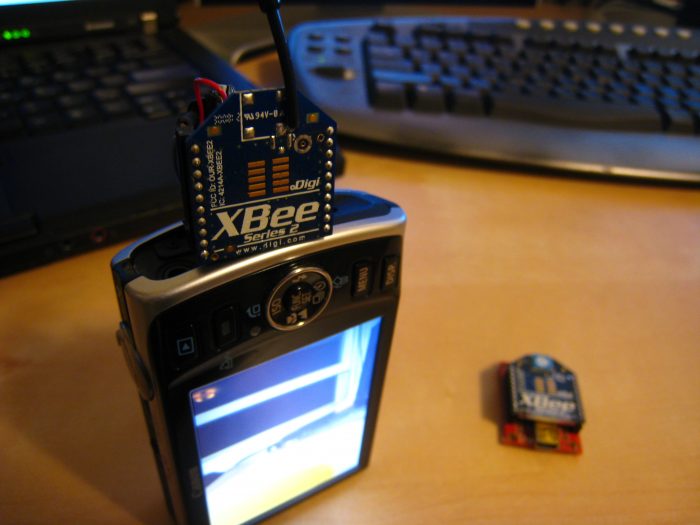
I’ve been trying to get as much use as possible out of these XBees before I have to return them to my department. CHDK was perhaps the main reason I paid the premium for a Canon SD870, but I haven’t had time to play around with it until now. One of the features CHDK has enabled is remote triggering via the USB port on the camera. Most solutions I’ve seen around the internet are wired or use hacked apart doorbells. I thought it would be nice to have it both wireless and computer controlled.
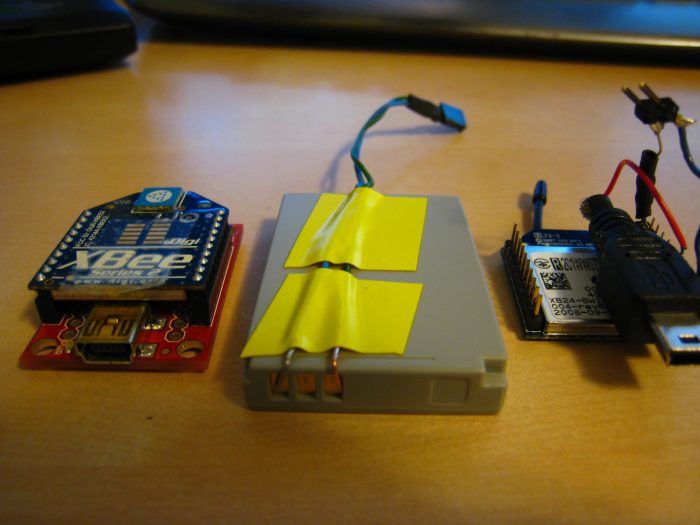
The entire project is almost absurdly simple, and the part count on the camera end is merely an XBee, a pin header to avoid soldering to it, a hacked apart mini USB cable, and a resistor. The XBee is powered off of the camera’s onboard lithium ion by running wires straight off of the battery contacts. Luckily, there is a hole in the battery door that I could route the ground and VCC wires through. I stuck a 7.5 ohm resistor on VCC to pull it down a little to avoid burning the XBee, but it probably isn’t necessary. The +5 line on USB is then just connected to one of the digital IO pins on the XBee, pin 7 in my case. The XBee on the camera and the one on the computer are programmed into API mode. All that is left is having a simple Python script using the python-xbee library to toggle the remote pin up and down to take a picture. The main downside is the constant 50mA draw on the battery, though you could probably use some kind of sleep mode on the XBee to save power.
Download: XBee Trigger
XBee Enabled Arduino Based Wireless Multimeter
The title of this post is almost too thick with geeky goodness. This past week, the ECE department at CMU held the kind of event I’ve been dreaming of for years: give a bunch of students free parts and access to labs and see what happens. The event was called build_18 (sorry, no public site at the moment), and was the brainchild of Boris Lipchin. There were some pretty amazing projects, like a laser guided Nerf chain gun.
My roommate, Donald Cober, and I were planning on bringing back an old idea we never finished, a multimeter glove. We decided that wasn’t difficult enough though, and added the killer feature of being able to stream data back to a computer for logging and display. We had XBees left from the Wand project, so a serial point to point link using them was the logical choice. We planned to read DC voltage, current, resistance, and temperature, and be autoranging on the first three. Due to finals and catching up on a semester of missed sleep, we didn’t start the project until the morning before build_18 ended, so we had to drop the glove, ignore the onboard LCD (scavenged from an HP Laserjet), and focus on just getting voltage right. Donnie had planned to build a Lithium Polymer battery board for Arduino, but we ended up having to power it off of Solio solar chargers that we won at a Yahoo University Hack Day last semester. The multimeter itself is basically just a quad op amp, a few resistor networks, and some zener diodes sitting on an Arduino protoboard shield plugged into an Arduino Diecimila. It actually worked quite nicely. It is accurate from about -20 to 20 V and samples at about 2000 Hz, enough to see a nice sine wave on 60 Hz AC.

We are planning on finishing the other three data lines and getting the LCD working, so I will post again later with working schematics and an Arduino sketch. I’m not going to leave you with nothing though. The plotting app on the computer end is reasonably complete. We used matplotlib with threading to avoid losing data. It is fairly specific to our hardware, but it can at least serve as an example of how to do real time plotting in python.
Download: Multimeter Real Time Plotting Front End
Mr. Mummy in: Mummy Daycare
Yet another amusing artifact of my semester. This one comes with a domain name.
Magic Wands: ZigBee Enabled Group Gaming
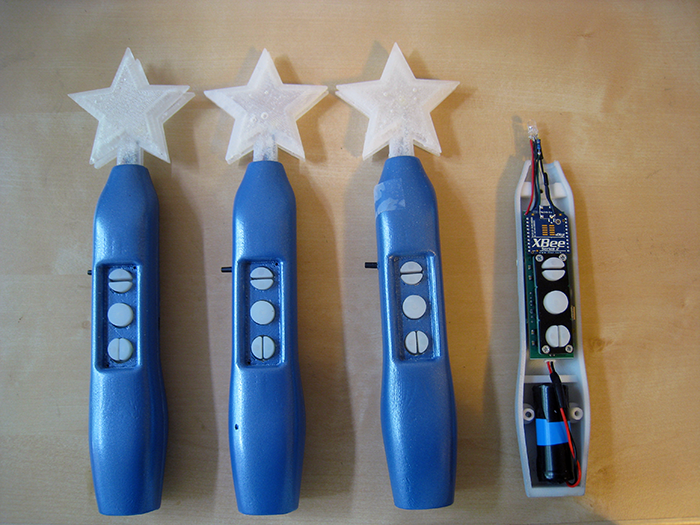
Over the last semester, my 18-549 group of Adeola Bannis, Claire Mitchell, Ethan Goldblum, and I has designed and prototyped a magic wand for theme park patrons to use for group games while waiting in long lines. The initial idea of a crowd interaction device (and several thousand dollars of funding) was provided by Disney Research, but we ran with the concept, adding ZigBee wireless networking, an accelerometer, IR tracking via webcam, location based gaming, and so on. We also wrote a few proof of concept games to go along with it. I lost more sleep over this class than any other I’ve taken, but I learned quite a bit more as well.
The hardware is based loosely on Arduino, and we used their bootloader. The software is a modified xbee-api-on-arduino library and code to interface the hardware. The wand consists of an ATmega168, a 3-axis analog accelerometer, a Series 2 XBee, power and lithium ion charging circuitry, a 1400 mAh lithium ion battery, a very highly mediocre button pad, an RGB LED, an IR LED, and an incredible enclosure that Zach Ali at dFAB designed for us. We went through a few hardware iterations before settling on this. The prototypes we built are probably around $60 each in parts, but dropping the XBee for a basic 802.15.4 IC and buying in bulk would drop it below $20. Our goal was to have the wand last a week long theme park visit without needing charged. Our current implementation doesn’t put the XBee to sleep, so it would last around 24 hours of constant use. Sleeping, we would reach about 9 days, surpassing the goal. Swapping out the XBee would also cut current draw in half. Wands can be charged over USB mini (yay for not using proprietary connectors!).
Perhaps the hardest part of the project was devising the network architecture and choosing where the divisions were between wand, server, and game. In general, the underlying network is abstracted completely away from both the wands and the games. The wands are simply advertised games that they are within range to play, and the games are sent joins when the wand joins the game. There are wand and server side timers to make sure that wands are never stuck inside a game if someone walks out of range of the network.
The server tracks all joins and parts from games in a database, and there is a web based interface to allow for user tracking. Perhaps my favorite simple gee-whiz feature that we added is remote battery level tracking. Each time a wand joins a game, its battery level is logged, which is displayed in the web interface. As the wands also have “display names” associated with them, it would be possible to tell someone, in game, that their battery level is low, if they ignore the red low battery LED on the wand.
The server is written in Java, using xbee-api to talk to wands and Google protobuf to serialize data to give to games. We wrote client side networking libraries for Java and Python. The games we wrote were mostly proof of concept to demonstrate the range of possible uses of the wand hardware.
The game below may look familiar. I have stated probably multiple times that I would never touch RocketPong again, but it always manages to pull me back in. In this variant, when a user joins the game, the star on their wand lights up with the color of their team, and their name appears next to their rocket. They then tilt their wand up and down to control the thrust of the rocket. The values between players on a team are averaged, so everyone on the team needs to cooperate if they want to win. It ended up being a lot of fun, and was probably the most popular game during our final demo. You can’t tell in the image below, but the star field in the background reacts to and collides with the ball, using the Lepton particle physics engine.
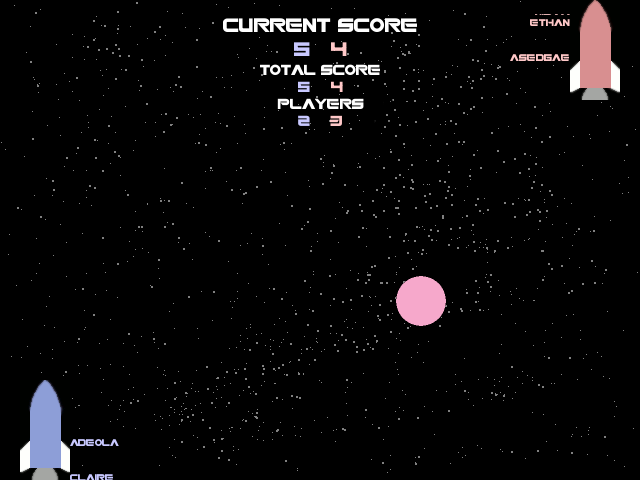
I also wrote a drawing game that uses the IR LED and a PS3 Eye modded with an IR filter. We had originally used floppy disks for the filter, but we eventually got the correct IR bandpass filter for our LEDs. I am really pleased with the PS3 Eye. It is the only webcam I’ve seen that can do 60 fps VGA in Linux, and it also works beautifully with Pygame’s camera module. The game is just a basic virtual whiteboard, allowing people to use their wand as a marker. Pressing the buttons on the wand changes the color being drawn. The whiteboard slowly fades away to white, erasing old drawings as the line moves on. I had hoped to allow for multiple people to draw at the same time, but ran out of time.
During our final all-nighter, I quickly wrote a music app using the new Pygame midi module. On joining the game, a user selects one of five instruments. For the two percussion instruments, the user can shake the wand like a maraca or hit like a drumstick, using the accelerometer to trigger sound. The other three instruments use the button pad to play notes. Just because I could, this game also uses Lepton to shoot off music notes every time someone plays one. This game is a really watered down version of a project called Cacophony that I will be developing farther when I have time.
We also had a trivia/voting game, and a cave game clone, which I did not write.
I doubt the project as a whole would be useful to anyone else out there, but individual chunks of it surely are. You can get code, schematics, documentation, and assorted other junk for the entire project at our gitorious repo. Note that parts of it probably don’t function, and much of it requires a very specific set of libraries. If you are really interested, I would be happy to help you use what you want of it. The licensing of just about everything is pretty murky, so talk to me first if you are planning on publishing anything based on this.
Coming Soon to a Theme Park Near You
Cheap 3D in OpenGL with a ChromaDepth GLSL Shader
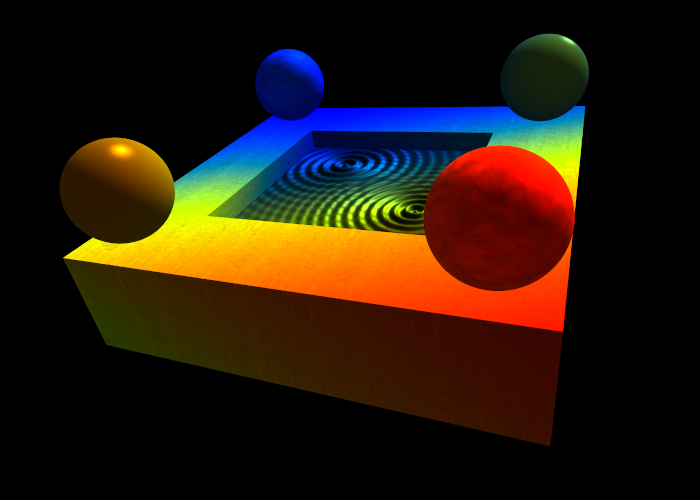
I have probably stated in the past that I don’t do 3d. As of a few months ago, this is no longer accurate. Between Deep Sheep, a computer graphics course, and a computer animation course, I have grown an additional dimension. This dimension is now bearing dimensional fruit.
After watching Coraline in 3d over spring break, I became obsessed with the possibilities of 3d. Of course, as a student, I can’t quite afford fancy glasses or a polarized projector. My budget is a bit closer to the free red/blue glasses one might find in a particularly excellent box of cereal. Searching around the internet, and eBay specifically, I came across a seemingly voodoo-like 3d technology I’d never heard of: cardboard glasses with clear looking plastic sheet lenses that could turn hand drawn images 3d. This technology is ChromaDepth, which makes red objects appear to float in air, while blue objects seem to recede into the background. Essentially, it uses prisms to offset red and blue light by different amounts on each eye, giving an illusion of depth as your brain attempts to perceive it. So, creating a ChromaDepth image is just a matter of coloring objects at different distances differently, which is something computers are great at!
Of course, I am far from the first person to apply a computer to this. Mike Bailey developed a cool solution in OpenGL a decade ago which maps an HSV color strip texture based on the object’s depth in the image. The downside there is that objects can no longer have actual textures. Textures are pretty tricky with ChromaDepth, in that changing the color of an object will throw off the depth.
I wrote fragment and vertex shaders in GLSL that resolve this problem. The hue of the resulting fragments depends only on the distance from the camera in the scene, with closer objects appearing redder continuing through the spectrum to blue objects in the distance. The texture, diffuse lighting, specular lighting and material properties of the object set the brightness of the color, giving the illusion of shading and texture while remaining ChromaDepth safe. My code is available below. Sticking with the theme of picking a different license for each work, this is released under WTFPL. I can’t release the source of the OpenGL end of it, as it is from a school project. It should be fairly simple to drop into anything though. You will need ChromaDepth glasses to see the effect, which you can get on eBay or elsewhere for <$3 each.
Download:
ChromaDepth GLSL Vertex Shader
ChromaDepth GLSL Fragment Shader



